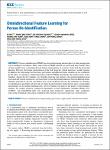Thông tin tài liệu
Thông tin siêu dữ liệu biểu ghi
| Trường DC | Giá trị | Ngôn ngữ |
|---|---|---|
| dc.contributor.author | Wu, D. | vi |
| dc.contributor.other | Yang, H. | vi |
| dc.contributor.other | Huang, D. | vi |
| dc.contributor.other | Yuan, C. | vi |
| dc.contributor.other | Qin, X. | vi |
| dc.contributor.other | Zhao, Y. | vi |
| dc.contributor.other | Zhao, X. | vi |
| dc.contributor.other | Sun, J. | vi |
| dc.date.accessioned | 2020-12-04T09:40:44Z | - |
| dc.date.available | 2020-12-04T09:40:44Z | - |
| dc.date.issued | 2019 | - |
| dc.identifier.uri | http://tailieuso.tlu.edu.vn/handle/DHTL/9859 | - |
| dc.description.abstract | Person re-identi cation (PReID) has received increasing attention due to it being an important role in intelligent surveillance. Many state-of-the-art PReID methods are part-based deep models. Most of these models focus on learning the part feature representation of a person's body from the horizontal direction. However, the feature representation of the body from the vertical direction is usually ignored. In addition, the relationships between these part features and different feature channels are not considered. In this paper, we introduce a multi-branch deep model for PReID. Speci cally, the model consists of ve branches. Among the ve branches, two branches learn the part features with spatial information from horizontal and vertical orientations; one branch aims to learn the interdependencies between different feature channels generated by the last convolution layer of the backbone network; the remaining two branches are identi cation and triplet sub-networks in which the discriminative global feature and a corresponding measurement can be learned simultaneously. All ve branches can improve the quality of representation learning. We conduct extensive comparison experiments on three benchmarks, including Market-1501, CUHK03, and DukeMTMC-reID. The proposed deep framework outperforms other competitive state-of-the-art methods. The code is available at https://github.com/caojunying/person-reidenti cation. | vi |
| dc.language | en_US | vi |
| dc.publisher | IEEE Xplore | vi |
| dc.relation.ispartofseries | IEEE Access, (2019), Vol 7, pp28402-28411 | vi |
| dc.subject | Person re-identi cation | vi |
| dc.subject | deep learning | vi |
| dc.subject | part feature | vi |
| dc.subject | triplet model | vi |
| dc.subject | identi cation model | vi |
| dc.title | Omnidirectional Feature Learning for Person Re-Identification | vi |
| dc.type | BB | vi |
| Trong bộ sưu tập: | Tài liệu hỗ trợ nghiên cứu khoa học | |
Danh sách tệp tin đính kèm:
Bạn đọc là cán bộ, giáo viên, sinh viên của Trường Đại học Thuỷ Lợi cần đăng nhập để Xem trực tuyến/Tải về
Khi sử dụng tài liệu trong thư viện số bạn đọc phải tuân thủ đầy đủ luật bản quyền.

